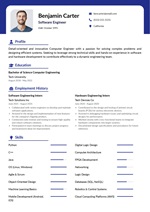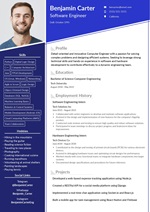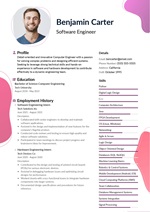In the digital era, where efficiency and accessibility reign supreme, the process of crafting a compelling resume has undergone a profound transformation. Online resume builders and traditional resume templates represent two distinct avenues for job seekers, each offering unique benefits and limitations.
Understanding Online Resume Builders
As the name suggests, online resume builders provide a digital platform for individuals to create professional resumes quickly and conveniently. These platforms typically offer a range of templates and customization options to suit various industries and career levels.
Customization Options: Online resume builders empower users to tailor their resumes to their specific needs, with features like customizable sections, font choices, and color schemes.
Accessibility: One of the primary advantages of online resume builders is their accessibility - users can create and edit their resumes from any device with an internet connection, eliminating the need for specialized software.
Integration Features: Many online resume builders offer integration with other platforms, such as LinkedIn or personal portfolios, allowing users to seamlessly incorporate additional information into their resumes.
Pros of Online Resume Builders
Speed and Efficiency: Perhaps the most significant advantage of online resume builders is their ability to streamline the resume-building process, enabling users to create polished resumes in a matter of minutes.
User-Friendly Interfaces: These platforms typically feature intuitive interfaces that guide users through the resume-building process, making it accessible even to those with limited technical skills.
Dynamic Templates: Online resume builders often offer a diverse range of templates, including modern and creative designs, allowing users to stand out from the competition.
Cloud Storage: By storing resumes in the cloud, online builders ensure that documents are securely backed up and accessible from any device, mitigating the risk of data loss.
Collaboration Tools: Some online resume builders offer collaboration features, allowing multiple users to work on the same document simultaneously, making it ideal for team projects or feedback sessions.
Cons of Online Resume Builders
Limited Customization: While online resume builders offer a degree of customization, users may find themselves constrained by the templates' pre-defined layouts and design elements.
Dependency on Internet Connection: Given that online resume builders operate on web-based platforms, users may encounter difficulties accessing or editing their resumes without a stable internet connection.
Compatibility Issues: Ensuring compatibility with applicant tracking systems (ATS) can be challenging, as certain formatting features or file types may not translate well into these systems.
Privacy Concerns: Users must consider the security of their personal data when using online resume builders, ensuring that sensitive information remains protected from potential breaches.
Subscription Costs: While many online resume builders offer free basic plans, access to premium features may require a subscription fee, which could be prohibitive for some users.

Exploring Traditional Resume Templates
Despite the rise of online resume builders, traditional resume templates retain their appeal for many job seekers, offering familiarity, control, and compatibility.
Classic Designs: Traditional resume templates often feature timeless layouts and formats that have stood the test of time, making them a reliable choice for job applications in any industry.
Microsoft Word Templates: Widely accessible and easy to use, Microsoft Word templates provide users with a familiar environment for creating and editing resumes, eliminating the need for specialized software.
PDF Templates: PDF resumes ensure consistency across different devices and operating systems, maintaining the integrity of the document's layout and formatting.
Pros of Traditional Resume Templates
Complete Control: Unlike online resume builders, traditional templates offer users complete control over the design and layout of their resumes, allowing for greater customization and personalization.
Offline Accessibility: Traditional resume templates do not require an internet connection for editing or sharing, making them ideal for users who need to work offline or prefer to keep their documents local.
ATS Compatibility: By adhering to standard formatting guidelines, traditional resume templates are generally compatible with ATS, ensuring that resumes pass through these systems without issue.
One-Time Cost: Unlike online resume builders, which may require a subscription fee for access to premium features, traditional templates typically incur a one-time cost or are freely available online.
Privacy Assurance: With traditional templates, users retain full control over their personal data, minimizing the risk of privacy breaches associated with online platforms.
Cons of Traditional Resume Templates
Design Limitations: While traditional templates offer flexibility, they may lack the dynamic design elements and modern layouts available in online resume builders, potentially limiting users' ability to stand out.
Technical Skills Required: Customizing traditional templates may require proficiency in design software such as Adobe InDesign or Illustrator, posing a barrier to users with limited technical skills.
Version Control Challenges: Managing multiple revisions of a resume can be cumbersome with traditional templates, as users must manually update and track changes across different files.
Compatibility Concerns: Ensuring compatibility across various devices, operating systems, and software versions can be challenging with traditional templates, potentially leading to formatting issues or discrepancies.
Time-Consuming Updates: Making changes to a traditional resume template often involves manual editing, which can be time-consuming, especially for users with multiple versions or iterations of their resume.
Conclusion
In the perennial debate between online resume builders and traditional resume templates, there is no one-size-fits-all solution. Each option presents its own set of pros and cons, and the best choice ultimately depends on the individual preferences, needs, and circumstances of the job seeker.
Final Thoughts
As technology continues to evolve, so too will the landscape of resume building. By understanding the strengths and limitations of both online resume builders and traditional templates, job seekers can make informed decisions to maximize their chances of success in today's competitive job market.
Traditional Resume Templates Supported by Online Resume Builders
It's worth noting that many online resume builders offer support for traditional resume templates in addition to their own proprietary designs. Platforms like Resume-Builder.Pro provide users with a variety of options, including classic Word and PDF templates, alongside their modern template offerings. This integration allows users to leverage the familiarity and flexibility of traditional templates while still benefiting from the convenience and features of online resume builders.






